User engagement metrics, which measure what users do on your website and how they do it (such as time on page, session duration, bounce rate, and returning users), have become unofficial ranking signals with Google.
Gone are the days when posting a 400-word article with a 2% keyword density could boost a page’s search rankings. Now, poor quality content has a far more negative impact on a site, causing it to drown in a sea of content that was created just for SEO purposes.
Yes, the way content is interacted with online is definitely on Google’s radar, as shown by Google’s recent patent filing. So, while creating a sound content marketing strategy is necessary to attract and retain users, it also improves a site’s Google search rankings. Therefore, focus on producing quality content, and you will reap a boost in SERP rankings as a secondary benefit.
The key is to always strategize before producing any content. Don’t just simply churn out content for content’s sake. Once you start producing great content and your users engage with it and boost rankings at the same time, you’ll understand why this is the far superior approach.
It isn’t as hard as it sounds, either. The tips in this article will help you. Now, let’s get started on the first step, which is to define your goals.
Define Your Goals
Great content is created for a specific purpose, and this purpose needs to be defined. Ask yourself if you are creating content to boost brand awareness, generate leads, convert users, attract past customers, improve search ranking results, or something else altogether.
Once you have clearly defined your goals, you need to determine if a content strategy is in fact the best way to achieve them. Don’t assume content is the best option in every situation. For instance, content might be of little use in converting users at the bottom of the sales funnel; however, it could be invaluable in boosting brand awareness and lead generation.
Different segments of the sales funnel warrant different types of content. So, you will need to decide what content is most appropriate for a person to receive at a given time. That way, you will have the right conversation with the right person at the right time.
HubSpot provides some useful information on the types of content that are needed in different parts of the sales funnel. The company divides the sales funnel into three key areas, and then lists the appropriate content asset types for each in the graphic below:
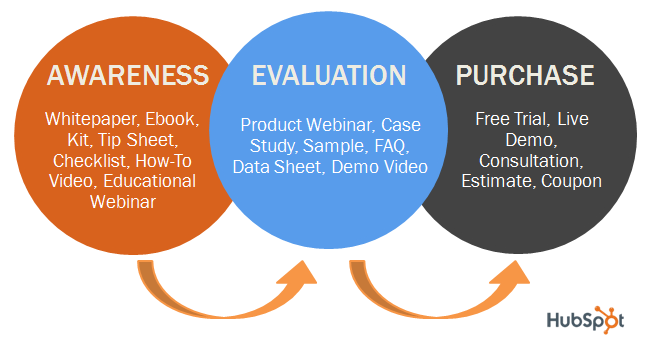
Research Your Audience
Your content strategy can be effective when you know who your audience is. Valuable information can be gleaned by checking what types of sites your prospects are already visiting, which content they engage with, and which social media platforms they share content on. This can be done by enabling Google Demographics and Interests for the types of sites prospects engage with and Google Analytics for the content they engage with, and by reviewing which social platforms are more popular for sharing on content pages.
Delve into Google Analytics to determine which content is producing the best results. Click on Behavior>Site Content>Content Drilldown. To find the best results, sort by different factors such as Average Time on Page, Bounce Rate, and Pageviews. With this information, create content that is targeted to the user, rather than content that you want to read. Your goals for creating this content are to increase Average Time on Page, decrease Bounce Rate, and increase Pageviews.
Focus on Your Niche
It’s a sad fact that the Internet is full of content that shouldn’t even exist. This content either already exists elsewhere and is simply reposted or doesn’t provide any real value. Most people don’t see 99% of this useless content because it doesn’t appear anywhere near the top of SERPs.
To avoid having your content lost in that pack, create content that stands out, is unique, has a distinct voice, and, most important, offers genuine value to readers.
The more specific you are and the more you focus on your niche, the greater your chances of establishing yourself as an authority in your field, whether your readers are looking for information or entertainment.
One business that has done this successfully is the rum brand Sailor Jerry (although this example isn’t specifically about content marketing). The company hosted a marketing event in Brooklyn at which they gave away a free shot of Sailor Jerry to every fan who was willing to get inked permanently with a Sailor Jerry tattoo. This created a lot of brand exposure for Sailor Jerry, but the real benefit was creating a stronger link with its loyal fan base.
While most of the fans of your brand probably aren’t about to tattoo your logo on their bodies any time soon, there are nonetheless important lessons to learn here about building a strong connection with a focused and loyal user base, which is usually more effective than having superficial links to a larger base that is more general in nature.
Measure Your Results
Measuring the results of your content marketing efforts is one of the most important aspects of developing an effective content strategy. Churning out content without analyzing your user feedback is akin to having a phone conversation on mute. You need to know what your audience liked as well as what they didn’t like, and why. Here are some of the most important metrics to understand.
Consumption Metrics
This is the first layer of information you can gather when people view your content. As previously mentioned, and as shown in the screenshot below, you get this data from Google Analytics by clicking on Behavior>Site Content>Content Drilldown. You can sort by different factors such as Average Time on Page, Bounce Rate, and Pageviews.
With this data, you can find answers to questions like these: Did you craft a blog post that brought on a huge spike in traffic? Did your users spend more time on a particular piece or genre of content? Did a piece of content garner a large number of comments or shares on social media?
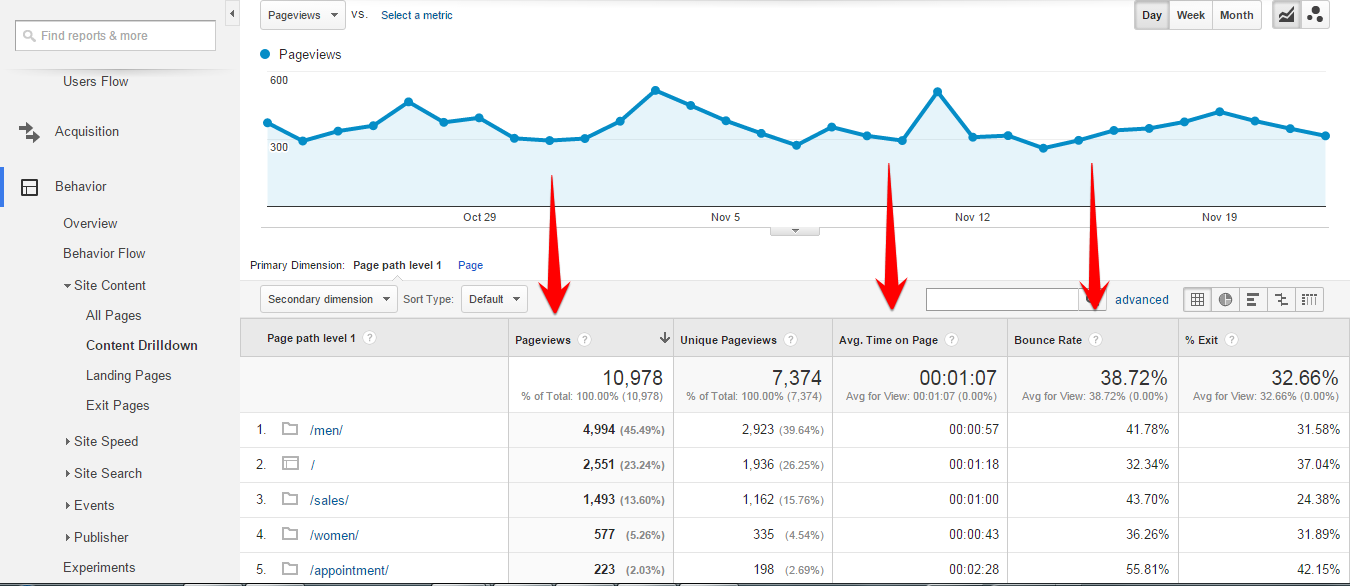
Social Sharing Metrics
Sharing on platforms like social media can be a great metric for judging how engaged your audience is. Ask yourself what types of content are being shared, who is sharing, which platforms are being used, and, most important, what content is converting. Below are the steps for how to find what content is converting:
- Log into Google Analytics.
- Click on Acquisition>Social>Overview.
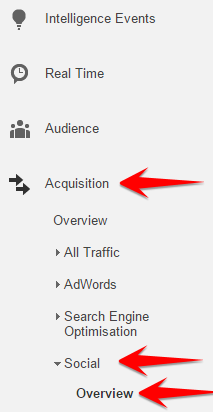
Then you will have a report similar to the one below (assuming you have goals set up):

Here, you have three important metrics:
Conversions: This shows you the total number and amount of conversions. They are from every traffic source, not only social.
Assisted Social Conversions: In order for an assisted social conversion to register, a visitor must have visited the social media site once, though they may have used another traffic source before the last part of the conversion.
Last Interaction Social Conversions: Visitors are attributed to this group if they came from social media and completed the assigned goal in the same session.
Once you have this data, it will yield insights into the style of content that needs to be created in order to get conversions. Also, you will be able to decipher which social media platforms are working best. (Take into account that some niches encourage sharing more than others, so compare your performance with those of competitors with a similar user base.)
Lead Metrics
If your content is part of a sales funnel, ask yourself which part of the sales funnel you are creating the content for. Content needs to be tailored to the specific audience at each segment of a sales funnel.
Your content could be either attracting or leaking leads, so monitor its performance and identify areas that could be improved to stop users from dropping out of the sales funnel and areas that could generate new leads. The quickest and easiest way to track leads is to use goals in Google Analytics.
The easiest type of goal to set up is a URL destination goal. Here are the steps:
- Log into Google Analytics.
- Click on Conversions>Goals>Goal URLs.
- Then click the “Set up goals” button.
- Then click the “+NEW GOAL” button.
- Then select Template (shown in step 7 below).
- Then type in a description for your goal (shown in step 7 below).
- Then select Destination, and click the “Continue” button.
- In goal details, you need to add the URL of the goal you want to track. The whole URL is not needed, just the final path. For example, to track www.example.com/thankyou.html, input only /thankyou.html.
Here, you will have two optional details:
Value: It is possible to assign a value to the goal. For example, if you are selling a product for a specific price, you can add it here.
Funnel: It is also possible to track a specific part of the sales funnel by adding it to the goal. For example, if you need to know how many people visit www.example.com/pricing.html before completing a goal, then add /pricing.html into the field.
- Then click save and that’s it.
- To view goals once they are set up click Conversions>Goals>Goal URLs
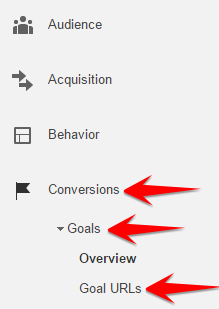


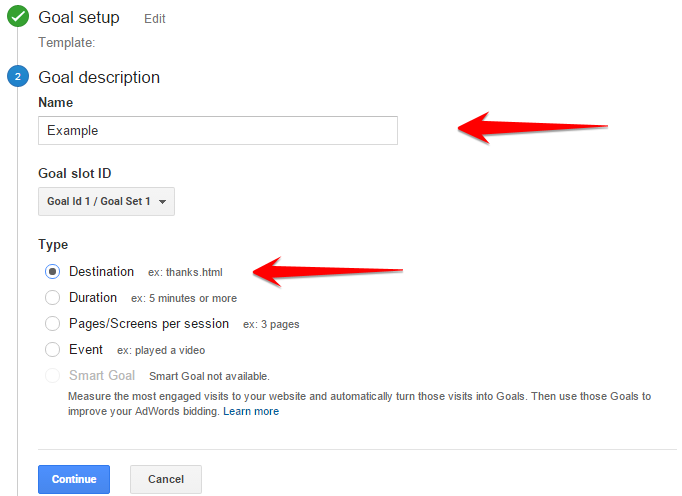
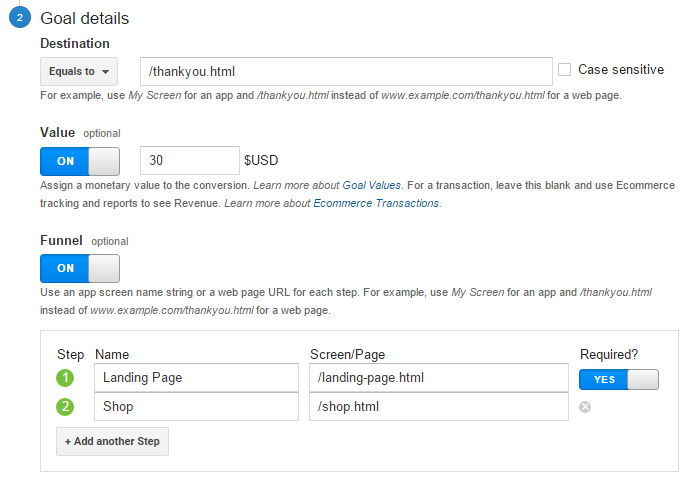

You should see something like this:

Sales Metrics
For most businesses, content generation ultimately should boost revenue. Therefore, if your content strategy is revenue-based, you will need to find ways to measure the amount of revenue your content marketing has generated.
Below are the steps for how to find the amount of revenue your content has generated:
- Log into Google Analytics.
- Click on Behavior>Site Content>All Pages.
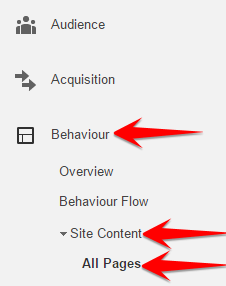
You should have something similar to this:

This will allow you to assign a value to a piece of content. If the content isn’t performing as needed, then check out this great article by Neil Patel on how to increase engagement with content.
Now, here is a picture that visually represents the four content marketing strategy metrics outlined above:
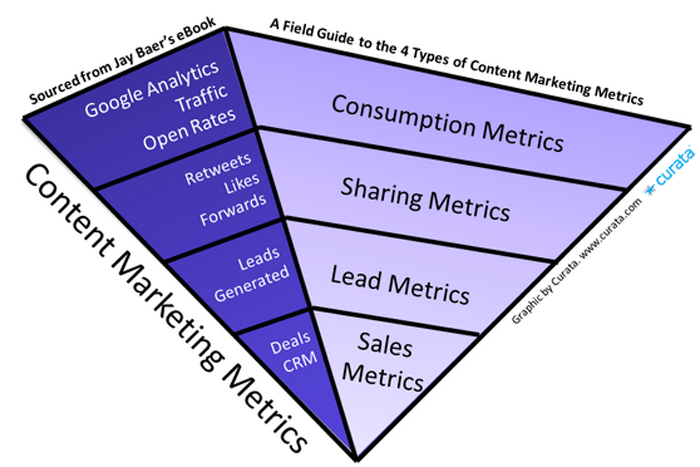
Listen to Your Customers
While data analysis can be an immensely useful tool, it gives you only black and white figures on a spectrum that encompasses a lot of subtleties. Access the rest of that spectrum by really listening to your customers. Your customers need to know they are being heard on social media, so ask them for feedback and suggestions.
Also speak to other members of your staff to get a better understanding of the needs of your customers. Reaching out to your customers and responding to their feedback enables you to gather valuable data, and it also shows them that their opinion matters.
Virgin.com provided an excellent case study by showing how they utilized big data. They incorporated search terms used on the web, people being followed on social media platforms, and views and interests expressed online.
Using the data below, they dug deep and incorporated it into their communications, successfully giving audiences the right message at the appropriate parts of the customer journey. Find out more here.
Here is a flowchart of the results:
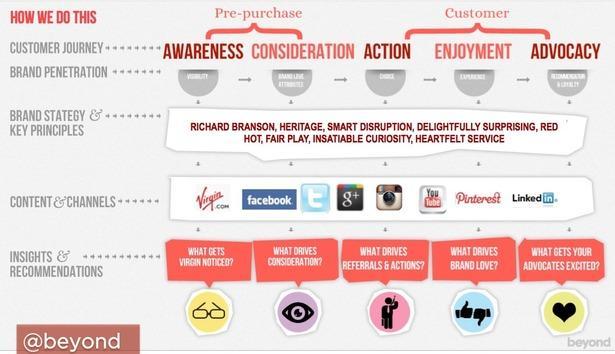
Amplify Your Content
A sound content strategy and targeted content creation make up only the first part of the equation. The final part is amplification of the content.
To amplify your content, determine the places your audience is frequenting online, and then publish on those channels to reach them. You’ll need to think strategically in order to identify all the resources available to you and then harness the power of employees, customers, and influencers to really amplify your content.
Conclusion
As you can see, creating a great content strategy isn’t rocket science, but it can be quite challenging to implement. Expect to encounter roadblocks and go through lots of trial and error. Once you have a recipe for success, though, all you’ll have to do is rinse and repeat to see the kind of audience growth you’ve always dreamed of.
About the Author: Brie Moreau is a Digital Marketing Analyst for DigitalAdvertisingWorks. DigitalAdvertisingWorks specializes in all areas of search engine optimization, has clients in many industries, and operates worldwide.
Comments (9)